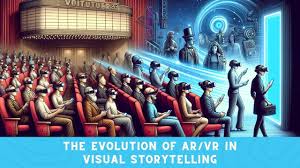Cinematic VR: The Evolution of Storytelling in Virtual Environments
Cinematic VR
Cinematic VR is a new and exciting way to tell stories. It allows viewers to immerse themselves in the world of the story and experience it from a first-person perspective. This can be incredibly powerful, as it allows viewers to connect with the characters and the story in a way that is simply not possible with traditional films or television shows.
Cinematic VR: The Evolution of Storytelling in Virtual Environments
Cinematic VR is a new and exciting way to tell stories. It allows viewers to immerse themselves in the world of the story and experience it from a first-person perspective. This can be incredibly powerful, as it allows viewers to connect with the characters and the story in a way that is simply not possible with traditional films or television shows.
Cinematic VR
Cinematic VR is a form of virtual reality that focuses on creating immersive and cinematic experiences. It uses advanced technology to create realistic and engaging environments that viewers can explore. This can be done using a variety of techniques, including 360-degree video, interactive environments, and motion capture.
The Evolution of Storytelling in Virtual Environments
The evolution of storytelling in virtual environments has been rapid in recent years. Early VR experiences were often limited to simple games or interactive simulations. However, as technology has advanced, developers have been able to create more sophisticated and engaging VR experiences. This has led to the emergence of cinematic VR, which uses the power of virtual reality to create truly immersive and cinematic experiences.
One of the key challenges of storytelling in VR is creating a sense of presence. This refers to the feeling that the viewer is actually in the world of the story. To create a sense of presence, developers must use a variety of techniques, including realistic visuals, sound design, and interactive elements.
Another challenge is creating a sense of narrative flow. In traditional films, the narrative is driven by the director's choices. However, in VR, the viewer has more control over their experience. This means that developers must be careful to design stories that can be experienced in a variety of ways.
The Future of Cinematic VR
The future of cinematic VR is very bright. As technology continues to advance, we can expect to see even more realistic and engaging VR experiences. This will open up new possibilities for storytelling, allowing creators to tell stories in ways that were never before possible.
Cinematic VR has the potential to revolutionize the way we tell stories. It offers a new level of immersion and interactivity that can engage viewers in a way that is simply not possible with traditional media. As the technology continues to develop, we can expect to see even more innovative and compelling cinematic VR experiences.
Summary
- Cinematic VR uses advanced technology to create realistic and engaging environments.
- The evolution of storytelling in VR has been rapid, with developers creating more sophisticated experiences.
- Challenges include creating a sense of presence and narrative flow.
- The future of cinematic VR is bright, with the potential to revolutionize storytelling.
